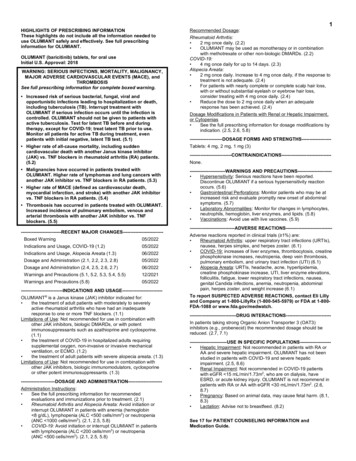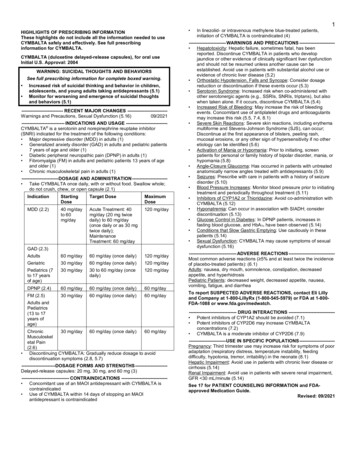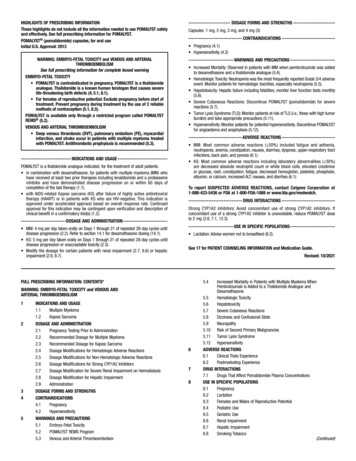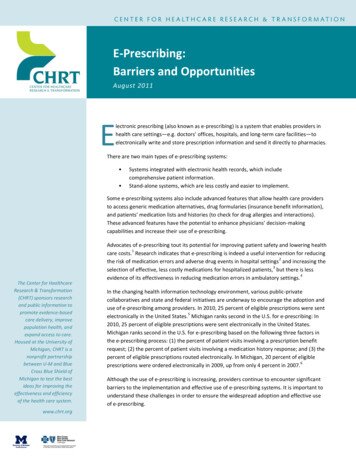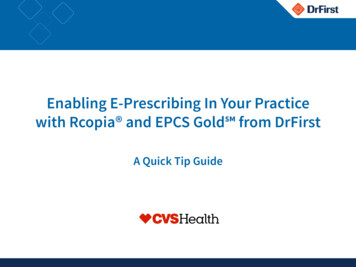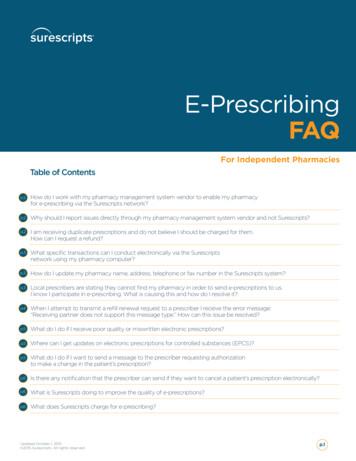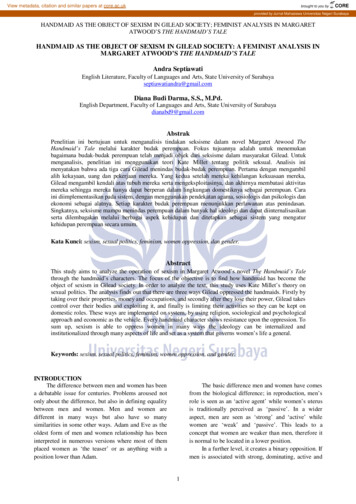
Transcription
HIGHLIGHTS OF PRESCRIBING INFORMATIONThese highlights do not include all the information needed to useLETAIRIS safely and effectively. See full prescribing informationfor LETAIRIS.Letairis (ambrisentan) tablets, for oral useInitial U.S. Approval: 2007WARNING: EMBRYO-FETAL TOXICITYSee full prescribing information for complete boxed warning. Do not administer Letairis to a pregnant female because itmay cause fetal harm (4.1, 5.1, 8.1).Females of reproductive potential: Exclude pregnancy beforethe start of treatment, monthly during treatment, and 1 monthafter stopping treatment. Prevent pregnancy duringtreatment and for one month after stopping treatment byusing acceptable methods of contraception (2.2, 8.3).Because of the risk of embryo-fetal toxicity, for all femalepatients, Letairis is only available through a restrictedprogram under a Risk Evaluation and Mitigation Strategy(REMS) called the Ambrisentan REMS (5.2).-------------------------INDICATIONS AND USAGE-----------------------------Letairis is an endothelin receptor antagonist indicated for the treatmentof pulmonary arterial hypertension (PAH) (WHO Group 1): To improve exercise ability and delay clinical worsening. In combination with tadalafil to reduce the risks of diseaseprogression and hospitalization for worsening PAH, and toimprove exercise ability.Studies establishing effectiveness included trials predominantly inpatients with WHO Functional Class II–III symptoms and etiologies ofidiopathic or heritable PAH (60%) or PAH associated with connectivetissue diseases (34%) (1).-----------------------DOSAGE AND ADMINISTRATION---------------------- Initiate treatment at 5 mg once daily (2.1). May be started with tadalafil (2.1). Titrate at 4-week intervals as needed and tolerated (2.1). Do not split, crush, or chew tablets (2.1).FULL PRESCRIBING INFORMATION: CONTENTS*-------------------------DOSAGE FORMS AND STRENGTHS-----------------Tablet: 5 mg and 10 mg ------------------------------- Pregnancy (4.1) Idiopathic Pulmonary Fibrosis (4.2)-------------------------WARNINGS AND PRECAUTIONS--------------------- Fluid retention may require intervention (5.3). If patients develop acute pulmonary edema during initiation oftherapy with Letairis, consider underlying pulmonary venoocclusive disease and discontinue treatment if necessary (5.4). Decreases in sperm count have been observed in patients takingendothelin receptor antagonists (5.5). Decreases in hemoglobin have been observed within the first fewweeks; measure hemoglobin at initiation, at 1 month, andperiodically thereafter (5.6).------------------------------ADVERSE REACTIONS------------------------------ Most common adverse reactions ( 3% compared to placebo) areperipheral edema, nasal congestion, sinusitis, and flushing (6.1). When used in combination with tadalafil, most common adversereactions ( 5% compared with either monotherapy) are peripheraledema, headache, nasal congestion, cough, anemia, dyspepsia,and bronchitis (6.1).To report SUSPECTED ADVERSE REACTIONS, contact GileadSciences, Inc. at (1-800-445-3235, Option 3) or FDA at 1-800-FDA1088 or DRUG orine increases ambrisentan exposure; limit ambrisentan doseto 5 mg once daily (7).--------------------------USE IN SPECIFIC POPULATIONS------------------- Breastfeeding: Choose Letairis or breastfeeding (8.2). Not recommended in patients with moderate or severe hepaticimpairment (8.7).See 17 for PATIENT COUNSELING INFORMATION andMedication Guide.Revised: 08/20198.2 Lactation8.3 Females and Males of Reproductive PotentialWARNING: EMBRYO-FETAL TOXICITY8.4 Pediatric Use1 INDICATIONS AND USAGE8.5 Geriatric Use2 DOSAGE AND ADMINISTRATION8.6 Renal Impairment2.1 Adult Dosage8.7 Hepatic Impairment2.2 Pregnancy Testing in Females of Reproductive Potential10OVERDOSAGE3 DOSAGE FORMS AND STRENGTHS11 DESCRIPTION4 CONTRAINDICATIONS12 CLINICAL PHARMACOLOGY4.1 Pregnancy12.1 Mechanism of Action4.2 Idiopathic Pulmonary Fibrosis12.2 Pharmacodynamics5 WARNINGS AND PRECAUTIONS12.3 Pharmacokinetics5.1 Embryo-fetal Toxicity13 NONCLINICAL TOXICOLOGY5.2 Ambrisentan Risk Evaluation and Mitigation Strategy (REMS)13.1 Carcinogenesis, Mutagenesis, Impairment of Fertility5.3 Fluid Retention14 CLINICAL STUDIES5.4 Pulmonary Edema with Pulmonary Veno-occlusive Disease14.1 Pulmonary Arterial Hypertension (PAH)(PVOD)14.2 Combination Treatment of PAH5.5 Decreased Sperm Counts14.3 Long-term Treatment of PAH5.6 Hematological Changes14.4 Adverse Effects in Idiopathic Pulmonary Fibrosis (IPF)6 ADVERSE REACTIONS16 HOW SUPPLIED/STORAGE AND HANDLING6.1 Clinical Trials Experience17 PATIENT COUNSELING INFORMATION6.2 Postmarketing Experience*Sections or subsections omitted from the full prescribing information7 DRUG INTERACTIONSare not listed.8 USE IN SPECIFIC POPULATIONS8.1 PregnancyReference ID: 4481159
FULL PRESCRIBING INFORMATIONWARNING: EMBRYO-FETAL TOXICITYDo not administer Letairis to a pregnant female because it may cause fetal harm. Letairis isvery likely to produce serious birth defects if used by pregnant females, as this effect hasbeen seen consistently when it is administered to animals [see Contraindications (4.1),Warnings and Precautions (5.1), and Use in Specific Populations (8.1)].Exclude pregnancy before the initiation of treatment with Letairis. Females of reproductivepotential must use acceptable methods of contraception during treatment with Letairis and forone month after treatment. Obtain monthly pregnancy tests during treatment and 1 monthafter discontinuation of treatment [see Dosage and Administration (2.2) and Use in SpecificPopulations (8.3)].Because of the risk of embryo-fetal toxicity, for all female patients, Letairis is only availablethrough a restricted program under a Risk Evaluation and Mitigation Strategy (REMS) calledthe Ambrisentan REMS [see Warnings and Precautions (5.2)].1 INDICATIONS AND USAGELetairis is indicated for the treatment of pulmonary arterial hypertension (PAH) (WHO Group 1): To improve exercise ability and delay clinical worsening. In combination with tadalafil to reduce the risks of disease progression and hospitalization forworsening PAH, and to improve exercise ability [see Clinical Studies (14.2)].Studies establishing effectiveness included predominantly patients with WHO Functional Class II–IIIsymptoms and etiologies of idiopathic or heritable PAH (60%) or PAH associated with connectivetissue diseases (34%).2 DOSAGE AND ADMINISTRATION2.1 Adult DosageInitiate treatment at 5 mg once daily, with or without tadalafil 20 mg once daily. At 4-week intervals,either the dose of Letairis or tadalafil can be increased, as needed and tolerated, to Letairis 10 mg ortadalafil 40 mg.Do not split, crush, or chew tablets.2.2 Pregnancy Testing in Females of Reproductive PotentialInitiate treatment with Letairis in females of reproductive potential only after a negative pregnancytest. Obtain monthly pregnancy tests during treatment [see Use in Specific Populations (8.3)].3 DOSAGE FORMS AND STRENGTHS5 mg and 10 mg film-coated tablets for oral administration Each 5 mg tablet is square convex, pale pink, with “5” on one side and “GSI” on the other side.Reference ID: 44811592
Each 10 mg tablet is oval convex, deep pink, with “10” on one side and “GSI” on the other side.4 CONTRAINDICATIONS4.1 PregnancyLetairis may cause fetal harm when administered to a pregnant female. Letairis is contraindicated infemales who are pregnant. Letairis was consistently shown to have teratogenic effects whenadministered to animals. If this drug is used during pregnancy, or if the patient becomes pregnantwhile taking this drug, the patient should be apprised of the potential hazard to a fetus [see Warningsand Precautions (5.1, 5.2) and Use in Specific Populations (8.1)].4.2 Idiopathic Pulmonary FibrosisLetairis is contraindicated in patients with Idiopathic Pulmonary Fibrosis (IPF), including IPF patientswith pulmonary hypertension (WHO Group 3) [see Clinical Studies (14.4)].5 WARNINGS AND PRECAUTIONS5.1 Embryo-fetal ToxicityLetairis may cause fetal harm when administered during pregnancy and is contraindicated for use infemales who are pregnant. In females of reproductive potential, exclude pregnancy prior to initiationof therapy, ensure use of acceptable contraceptive methods, and obtain monthly pregnancy tests[see Dosage and Administration (2.2), and Use in Specific Populations (8.1, 8.3)].Letairis is only available for females through a restricted program under a REMS [see Warnings andPrecautions (5.2)].5.2 Ambrisentan Risk Evaluation and Mitigation Strategy (REMS)For all females, Letairis is available only through a restricted program under a REMS called theAmbrisentan REMS because of the risk of embryo-fetal toxicity [see Contraindications (4.1),Warnings and Precautions (5.1), and Use in Specific Populations (8.1, 8.3)].Important requirements of the Ambrisentan REMS include the following: Prescribers must be certified with the Ambrisentan REMS by enrolling and completing training. All females, regardless of reproductive potential, must enroll in the Ambrisentan REMS prior toinitiating Letairis. Male patients are not enrolled in the REMS. Females of reproductive potential must comply with the pregnancy testing andcontraception requirements [see Use in Specific Populations (8.3)].Pharmacies that dispense Letairis must be certified with the Ambrisentan REMS and mustdispense to female patients who are authorized to receive Letairis.Further information is available at www.ambrisentanrems.us.com or 1-888-417-3172.Reference ID: 44811593
5.3 Fluid RetentionPeripheral edema is a known class effect of endothelin receptor antagonists, and is also a clinicalconsequence of PAH and worsening PAH. In the placebo-controlled studies, there was an increasedincidence of peripheral edema in patients treated with doses of 5 or 10 mg Letairis compared toplacebo [see Adverse Reactions (6.1)]. Most edema was mild to moderate in severity.In addition, there have been postmarketing reports of fluid retention in patients with pulmonaryhypertension, occurring within weeks after starting Letairis. Patients required intervention with adiuretic, fluid management, or, in some cases, hospitalization for decompensating heart failure.If clinically significant fluid retention develops, with or without associated weight gain, furtherevaluation should be undertaken to determine the cause, such as Letairis or underlying heart failure,and the possible need for specific treatment or discontinuation of Letairis therapy.Peripheral edema/fluid retention is more common with Letairis plus tadalafil than with Letairis ortadalafil alone.5.4 Pulmonary Edema with Pulmonary Veno-occlusive Disease (PVOD)If patients develop acute pulmonary edema during initiation of therapy with vasodilating agents suchas Letairis, the possibility of PVOD should be considered, and if confirmed Letairis should bediscontinued.5.5 Decreased Sperm CountsDecreased sperm counts have been observed in human and animal studies with another endothelinreceptor antagonist and in animal fertility studies with ambrisentan. Letairis may have an adverseeffect on spermatogenesis. Counsel patients about potential effects on fertility [see Use in SpecificPopulations (8.6) and Nonclinical Toxicology (13.1)].5.6 Hematological ChangesDecreases in hemoglobin concentration and hematocrit have followed administration of otherendothelin receptor antagonists and were observed in clinical studies with Letairis. These decreaseswere observed within the first few weeks of treatment with Letairis, and stabilized thereafter. Themean decrease in hemoglobin from baseline to end of treatment for those patients receiving Letairisin the 12-week placebo-controlled studies was 0.8 g/dL.Marked decreases in hemoglobin ( 15% decrease from baseline resulting in a value below the lowerlimit of normal) were observed in 7% of all patients receiving Letairis (and 10% of patients receiving10 mg) compared to 4% of patients receiving placebo. The cause of the decrease in hemoglobin isunknown, but it does not appear to result from hemorrhage or hemolysis.In the long-term open-label extension of the two pivotal clinical studies, mean decreases frombaseline (ranging from 0.9 to 1.2 g/dL) in hemoglobin concentrations persisted for up to 4 years oftreatment.There have been postmarketing reports of decreases in hemoglobin concentration and hematocritthat have resulted in anemia requiring transfusion.Measure hemoglobin prior to initiation of Letairis, at one month, and periodically thereafter. Initiationof Letairis therapy is not recommended for patients with clinically significant anemia. If a clinicallyReference ID: 44811594
significant decrease in hemoglobin is observed and other causes have been excluded, considerdiscontinuing Letairis.6 ADVERSE REACTIONSClinically significant adverse reactions that appear in other sections of the labeling include: Embryo-fetal Toxicity [see Warnings and Precautions (5.1), Use in Specific Populations (8.1)] Fluid Retention [see Warnings and Precautions (5.3)] Pulmonary Edema with PVOD [see Warnings and Precautions (5.4)] Decreased Sperm Count [see Warnings and Precautions (5.5)] Hematologic Changes [see Warnings and Precautions (5.6)]6.1 Clinical Trials ExperienceBecause clinical trials are conducted under widely varying conditions, adverse reaction ratesobserved in the clinical trials of a drug cannot be directly compared to rates in the clinical trials ofanother drug and may not reflect the rates observed in practice.Safety data for Letairis are presented from two 12-week, placebo-controlled studies (ARIES-1 andARIES-2) in patients with pulmonary arterial hypertension (PAH), and one randomized, double-blind,active-controlled trial in 605 patients with PAH (AMBITION) comparing Letairis plus tadalafil toLetairis or tadalafil alone. The exposure to Letairis in these studies ranged from 1 day to 4 years(N 357 for at least 6 months and N 279 for at least 1 year).In ARIES-1 and ARIES-2, a total of 261 patients received Letairis at doses of 2.5, 5, or 10 mg oncedaily and 132 patients received placebo. The adverse reactions that occurred in 3% more patientsreceiving Letairis than receiving placebo are shown in Table 1.Table 1Adverse Reactions with Placebo-Adjusted Rates 3% in ARIES-1 and ARIES-2Placebo(N 132)Letairis(N 261)Adverse Reactionn (%)n (%)Placebo-adjusted(%)Peripheral edema14 (11)45 (17)6Nasal congestion2 (2)15 (6)4Sinusitis0 (0)8 (3)3Flushing1 (1)10 (4)3Most adverse drug reactions were mild to moderate and only nasal congestion was dose-dependent.Few notable differences in the incidence of adverse reactions were observed for patients by age orsex. Peripheral edema was similar in younger patients ( 65 years) receiving Letairis (14%; 29/205) orplacebo (13%; 13/104), and was greater in elderly patients ( 65 years) receiving Letairis (29%; 16/56)Reference ID: 44811595
compared to placebo (4%; 1/28). The results of such subgroup analyses must be interpretedcautiously.The incidence of treatment discontinuations due to adverse events other than those related to PAHduring the clinical trials in patients with PAH was similar for Letairis (2%; 5/261 patients) and placebo(2%; 3/132 patients). The incidence of patients with serious adverse events other than those relatedto PAH during the clinical trials in patients with PAH was similar for placebo (7%; 9/132 patients) andfor Letairis (5%; 13/261 patients).During 12-week controlled clinical trials, the incidence of aminotransferase elevations 3 x upper limitof normal (ULN) were 0% on Letairis and 2.3% on placebo. In practice, cases of hepatic injury shouldbe carefully evaluated for cause.Combination Use with TadalafilThe mean exposure to Letairis tadalafil in the AMBITION study was 78.7 weeks. The adversereactions that occurred in 5% more patients receiving Letairis tadalafil than receiving Letairis ortadalafil monotherapy in AMBITION are shown in Table 2.Table 2Adverse Reactions Reported More Commonly ( 5%) on Letairis Tadalafil thanon Letairis or Tadalafil Monotherapy (ITT) in AMBITIONLetairis TadalafilCombination Therapy(N 302)n (%)LetairisMonotherapy(N 152)n (%)TadalafilMonotherapy(N 151)n (%)Peripheral edema135 (45%)58 (38%)43 (28%)Headache125 (41%)51 (34%)53 (35%)Nasal congestion58 (19%)25 (16%)17 (11%)Cough53 (18%)20 (13%)24 (16%)Anemia44 (15%)11 (7%)17 (11%)Dyspepsia32 (11%)5 (3%)18 (12%)Bronchitis31 (10%)6 (4%)13 (9%)Adverse ReactionsPeripheral edema was more frequent on combination therapy; however, there was no notabledifference observed in the incidence of peripheral edema in elderly patients ( 65 years) versusyounger patients ( 65 years) on combination therapy (44% vs. 45%) or Letairis monotherapy (37%vs. 39%) in AMBITION.Treatment discontinuations due to adverse events while on randomized treatment were similar acrosstreatment groups: 16% for Letairis tadalafil, 14% for Letairis alone, and 13% for tadalafil alone.Use in Patients with Prior Endothelin Receptor Antagonist (ERA) Related Serum Liver EnzymeAbnormalitiesIn an uncontrolled, open-label study, 36 patients who had previously discontinued endothelin receptorantagonists (ERAs: bosentan, an investigational drug, or both) due to aminotransferase elevations 3x ULN were treated with Letairis. Prior elevations were predominantly moderate, with 64% of the ALTReference ID: 44811596
elevations 5 x ULN, but 9 patients had elevations 8 x ULN. Eight patients had been re-challengedwith bosentan and/or the investigational ERA and all eight had a recurrence of aminotransferaseabnormalities that required discontinuation of ERA therapy. All patients had to have normalaminotransferase levels on entry to this study. Twenty-five of the 36 patients were also receivingprostanoid and/or phosphodiesterase type 5 (PDE5) inhibitor therapy. Two patients discontinuedearly (including one of the patients with a prior 8 x ULN elevation). Of the remaining 34 patients, onepatient experienced a mild aminotransferase elevation at 12 weeks on Letairis 5 mg that resolvedwith decreasing the dosage to 2.5 mg, and that did not recur with later escalations to 10 mg. With amedian follow-up of 13 months and with 50% of patients increasing the dose of Letairis to 10 mg, nopatients were discontinued for aminotransferase elevations. While the uncontrolled study design doesnot provide information about what would have occurred with re-administration of previously usedERAs or show that Letairis led to fewer aminotransferase elevations than would have been seen withthose drugs, the study indicates that Letairis may be tried in patients who have experiencedasymptomatic aminotransferase elevations on other ERAs after aminotransferase levels havereturned to normal.6.2 Postmarketing ExperienceThe following adverse reactions were identified during post-approval use of Letairis. Because thesereactions were reported voluntarily from a population of uncertain size, it is not possible to estimatereliably the frequency or to establish a causal relationship to drug exposure: anemia requiringtransfusion [see Warnings and Precautions (5.6)] heart failure (associated with fluid retention),symptomatic hypotension, and hypersensitivity (e.g., angioedema, rash).Elevations of liver aminotransferases (ALT, AST) have been reported with Letairis use; in most casesalternative causes of the liver injury could be identified (heart failure, hepatic congestion, hepatitis,alcohol use, hepatotoxic medications). Other endothelin receptor antagonists have been associatedwith elevations of aminotransferases, hepatotoxicity, and cases of liver failure [see AdverseReactions (6.1)].7 DRUG INTERACTIONSMultiple dose coadministration of ambrisentan and cyclosporine resulted in an approximately 2-foldincrease in ambrisentan exposure in healthy volunteers; therefore, limit the dose of ambrisentan to 5mg once daily when coadministered with cyclosporine [see Clinical Pharmacology (12.3)].8 USE IN SPECIFIC POPULATIONS8.1 PregnancyRisk SummaryBased on data from animal reproduction studies, Letairis may cause fetal harm when administered toa pregnant woman and is contraindicated during pregnancy. There are limited data on Letairis use inpregnant women. In animal reproduction studies, Letairis was teratogenic in rats and rabbits at doseswhich resulted in exposures of 3.5 and 1.7 times, respectively, the human dose of 10 mg per day [seeAnimal Data]. If this drug is used during pregnancy, or if the patient becomes pregnant while takingthis drug, advise the patient of the potential hazard to a fetus [see Contraindications (4.1), Warningsand Precautions (5.1)].The estimated background risk of major birth defects and miscarriage for the indicated population isunknown. All pregnancies have a background risk of birth defect, loss, or other adverse outcomes. InReference ID: 44811597
the U.S. general population, the estimated background risk of major birth defects and miscarriage inclinically recognized pregnancies is 2-4% and 15-20%, respectively.DataAnimal DataLetairis was teratogenic at oral dosages of 15 mg/kg/day (AUC 51.7 h µg/mL) in rats and 7mg/kg/day (24.7 h µg/mL) in rabbits; it was not studied at lower dosages. These dosages are of 3.5and 1.7 times, respectively, the human dose of 10 mg per day (14.8 h µg/mL) based on AUC. In bothspecies, there were abnormalities of the lower jaw and hard and soft palate, malformation of the heartand great vessels, and failure of formation of the thymus and thyroid.A preclinical study in rats has shown decreased survival of newborn pups (mid and high dosages)and effects on testicle size and fertility of pups (high dosage) following maternal treatment withambrisentan from late gestation through weaning. The mid and high dosages were 51 x, and 170 x(on a mg/m2 body surface area basis) the maximum oral human dose of 10 mg and an average adultbody weight of 70 kg. These effects were absent at a maternal dosage 17 x the human dose basedon mg/m2.8.2 LactationRisk SummaryIt is not known whether ambrisentan is present in human milk. Because many drugs are present inhuman milk and because of the potential for serious adverse reactions in breastfed infants fromLetairis, a decision should be made whether to discontinue breastfeeding or discontinue Letairis,taking into account the importance of the drug to the mother.8.3 Females and Males of Reproductive PotentialPregnancy TestingFemale patients of reproductive potential must have a negative pregnancy test prior to initiation oftreatment, monthly pregnancy test during treatment, and pregnancy test 1 month after stoppingtreatment with Letairis. Advise patients to contact their healthcare provider if they become pregnant orsuspect they may be pregnant. Perform a pregnancy test if pregnancy is suspected for any reason.For positive pregnancy tests, counsel patient on the potential risk to the fetus and patient options [seeBoxed Warning and Dosage and Administration (2.2)].ContraceptionFemale patients of reproductive potential must use acceptable methods of contraception duringtreatment with Letairis and for 1 month after stopping treatment with Letairis. Patients may chooseone highly effective form of contraception (intrauterine device [IUD], contraceptive implant, or tubalsterilization) or a combination of methods (hormone method with a barrier method or two barriermethods). If a partner’s vasectomy is the chosen method of contraception, a hormone or barriermethod must be used along with this method. Counsel patients on pregnancy planning andprevention, including emergency contraception, or designate counseling by another healthcareprovider trained in contraceptive counseling [see Boxed Warning].Reference ID: 44811598
InfertilityMalesIn a 6-month study of another endothelin receptor antagonist, bosentan, 25 male patients with WHOfunctional class III and IV PAH and normal baseline sperm count were evaluated for effects ontesticular function. There was a decline in sperm count of at least 50% in 25% of the patients after 3or 6 months of treatment with bosentan. One patient developed marked oligospermia at 3 months,and the sperm count remained low with 2 follow-up measurements over the subsequent 6 weeks.Bosentan was discontinued and after 2 months the sperm count had returned to baseline levels. In22 patients who completed 6 months of treatment, sperm count remained within the normal rangeand no changes in sperm morphology, sperm motility, or hormone levels were observed. Based onthese findings and preclinical data [see Nonclinical Toxicology (13.1)] from endothelin receptorantagonists, it cannot be excluded that endothelin receptor antagonists such as Letairis have anadverse effect on spermatogenesis. Counsel patients about the potential effects on fertility [seeWarnings and Precautions (5.5)].8.4 Pediatric UseSafety and effectiveness of Letairis in pediatric patients have not been established.Juvenile Animal DataIn juvenile rats administered ambrisentan orally once daily during postnatal day 7 to 26, 36, or 62, adecrease in brain weight ( 3% to 8%) with no morphologic or neurobehavioral changes occurredafter breathing sounds, apnea, and hypoxia were observed, at exposures approximately 1.8 to 7.0times human pediatric exposures at 10 mg, based on AUC.8.5 Geriatric UseIn the two placebo-controlled clinical studies of Letairis, 21% of patients were 65 years old and 5%were 75 years old. The elderly (age 65 years) showed less improvement in walk distances withLetairis than younger patients did, but the results of such subgroup analyses must be interpretedcautiously. Peripheral edema was more common in the elderly than in younger patients.8.6 Renal ImpairmentThe impact of renal impairment on the pharmacokinetics of ambrisentan has been examined using apopulation pharmacokinetic approach in PAH patients with creatinine clearances ranging between 20and 150 mL/min. There was no significant impact of mild or moderate renal impairment on exposureto ambrisentan [see Clinical Pharmacology (12.3)]. Dose adjustment of Letairis in patients with mild ormoderate renal impairment is therefore not required. There is no information on the exposure toambrisentan in patients with severe renal impairment.The impact of hemodialysis on the disposition of ambrisentan has not been investigated.8.7 Hepatic ImpairmentPre-existing Hepatic ImpairmentThe influence of pre-existing hepatic impairment on the pharmacokinetics of ambrisentan has notbeen evaluated. Because there is in vitro and in vivo evidence of significant metabolic and biliarycontribution to the elimination of ambrisentan, hepatic impairment might be expected to haveReference ID: 44811599
significant effects on the pharmacokinetics of ambrisentan [see Clinical Pharmacology (12.3)]. Letairisis not recommended in patients with moderate or severe hepatic impairment. There is no informationon the use of Letairis in patients with mild pre-existing impaired liver function; however, exposure toambrisentan may be increased in these patients.Elevation of Liver TransaminasesOther endothelin receptor antagonists (ERAs) have been associated with aminotransferase (AST,ALT) elevations, hepatotoxicity, and cases of liver failure [see Adverse Reactions (6.1, 6.2)]. Inpatients who develop hepatic impairment after Letairis initiation, the cause of liver injury should befully investigated. Discontinue Letairis if elevations of liver aminotransferases are 5 x ULN or ifelevations are accompanied by bilirubin 2 x ULN, or by signs or symptoms of liver dysfunction andother causes are excluded.10 OVERDOSAGEThere is no experience with overdosage of Letairis. The highest single dose of Letairis administeredto healthy volunteers was 100 mg, and the highest daily dose administered to patients with PAH was10 mg once daily. In healthy volunteers, single doses of 50 mg and 100 mg (5 to 10 times themaximum recommended dose) were associated with headache, flushing, dizziness, nausea, andnasal congestion. Massive overdosage could potentially result in hypotension that may requireintervention.11 DESCRIPTIONLetairis is the brand name for ambrisentan, an endothelin receptor antagonist that is selective for theendothelin type-A (ETA) receptor. The chemical name of ambrisentan is( xy-3,3-diphenylpropanoic acid. It has a molecularformula of C22H22N2O4 and a molecular weight of 378.42. It contains a single chiral center determinedto be the (S) configuration and has the following structural formula:Figure 1Ambrisentan Structural FormulaCH3COOHH3CONONCH3Ambrisentan is a white to off-white, crystalline solid. It is a carboxylic acid with a pKa of 4.0.Ambrisentan is practically insoluble in water and in aqueous solutions at low pH. Solubility increasesin aqueous solutions at higher pH. In the solid state ambrisentan is very stable, is not hygroscopic,and is not light sensitive.Letairis is available as 5 mg and 10 mg film-coated tablets for once daily oral administration. Thetablets include the following inactive ingredients: croscarmellose sodium, lactose monohydrate,magnesium stearate and microcrystalline cellulose. The tablets are film-coated with a coating materialcontaining FD&C Red #40 aluminum lake, lecithin, polyethylene glycol, polyvinyl alcohol, talc, andtitanium dioxide. Each square, pale pink Letairis tablet contains 5 mg of ambrisentan. Each oval,deep pink Letairis tablet contains 10 mg of ambrisentan. Letairis tablets are unscored.Reference ID: 448115910
12 CLINICAL PHARMACOLOGY12.1 Mechanism of ActionEndothelin-1 (ET-1) is a potent autocrine and paracrine peptide. Two receptor subtypes, ETA andETB, mediate the effects of ET-1 in the vascular smooth muscle and endothelium. The primaryactions of ETA are vasocon
Ambrisentan REMS because of the risk of embryo-fetal toxicity [see Contraindications (4.1), Warnings and Precautions (5.1), and Use in Specific Populations (8.1, 8.3 )]. Important requirements of the Ambrisentan REMS include the following: x Prescribers must be certified with the Ambrisentan REMS by enrolling and completing training.

